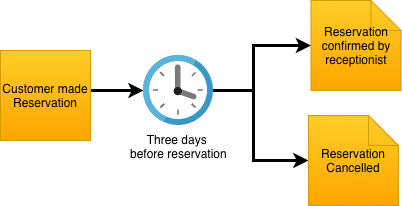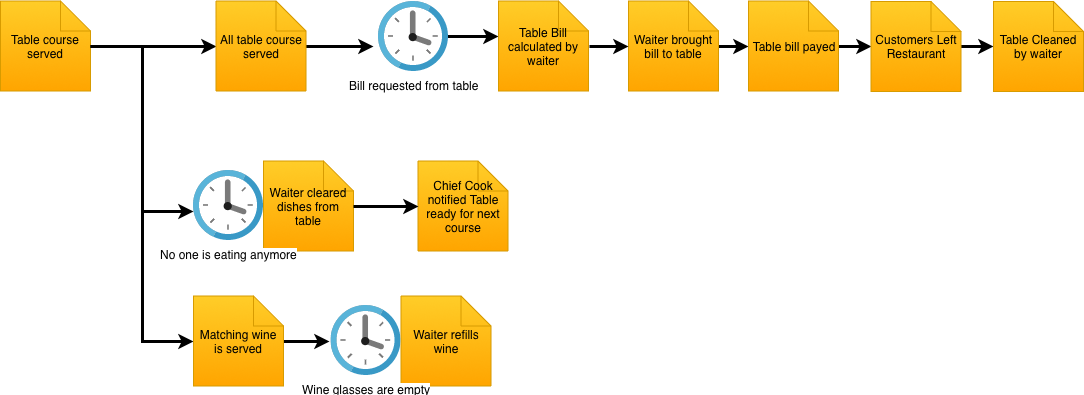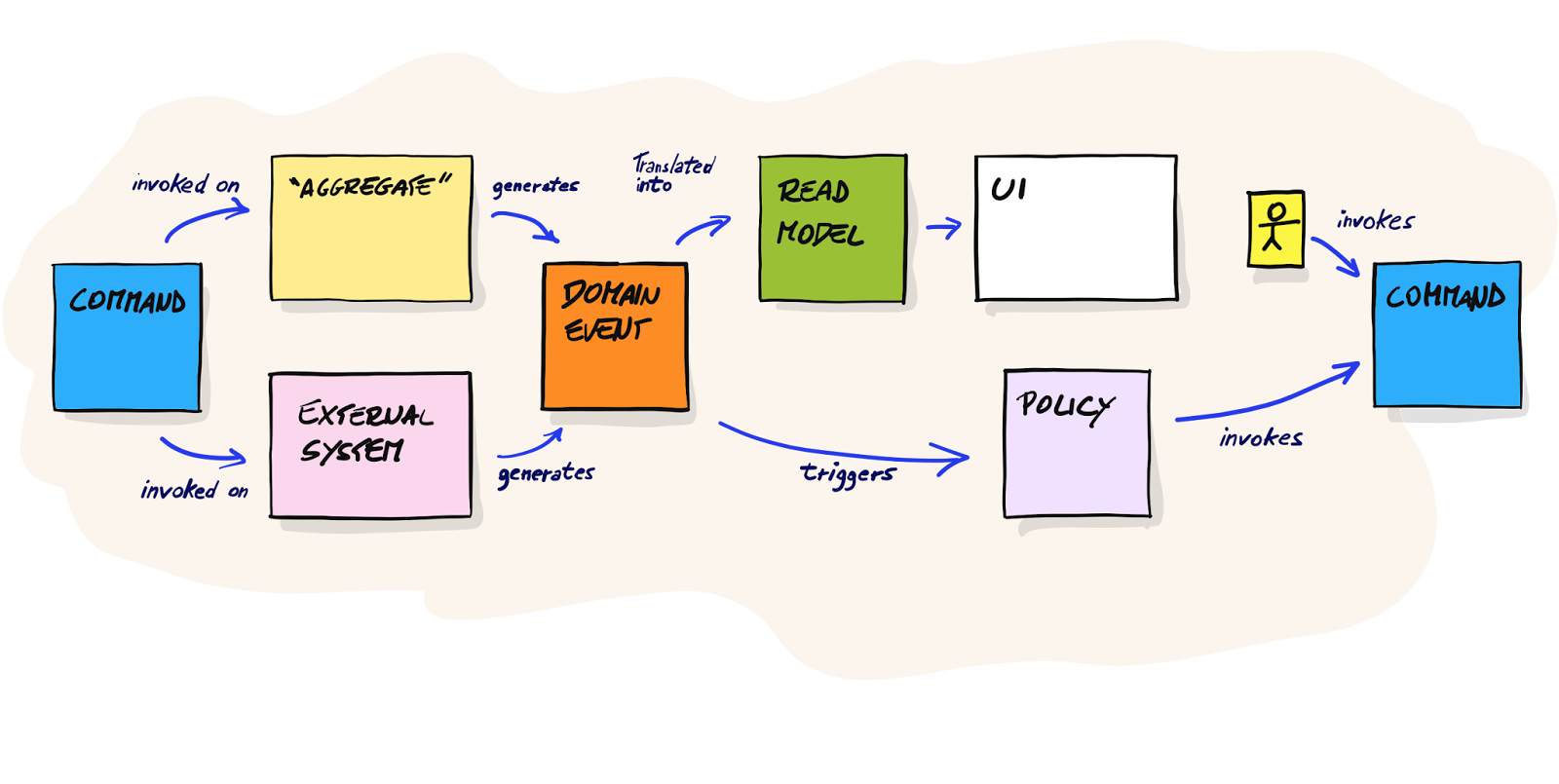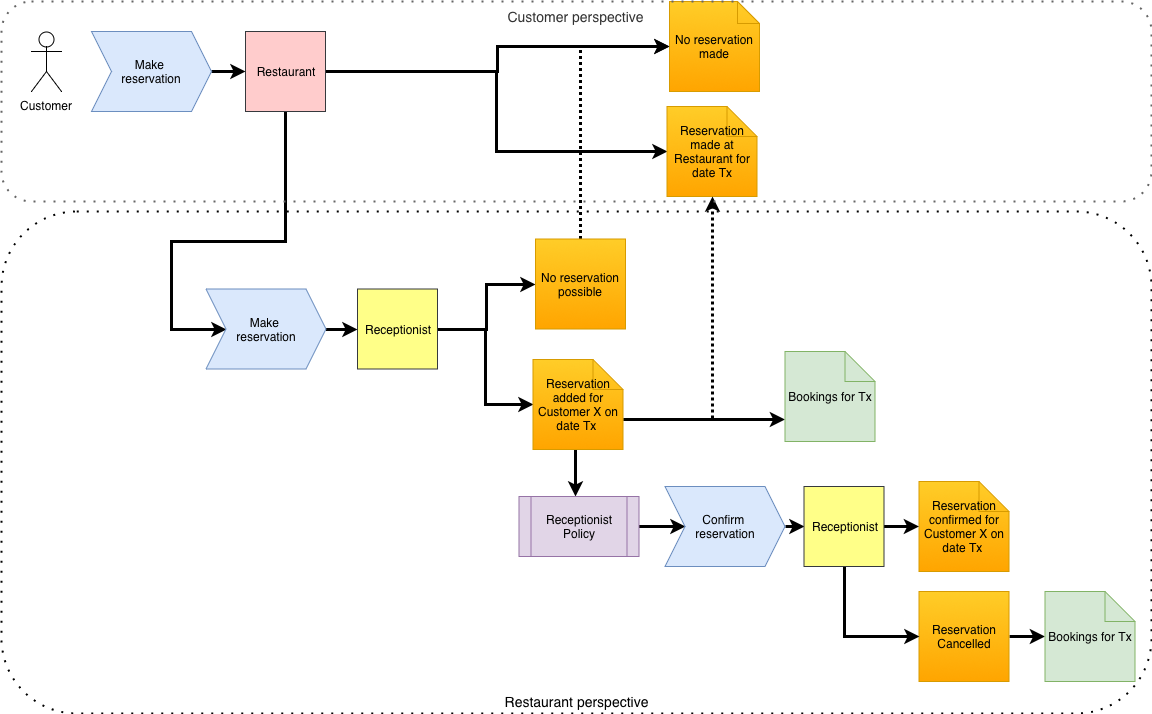Event Storming a restaurant
I am a big fan of Event Storming1, a technique that was created by Alberto Brandolini2. Despite its chaotic ‘storming’ nature, Event Storming has the ability to turn confusion into clarity. Because telling a story, on a timeline, is really how people’s brain work. Which is probably why we have user stories and not “user click actions and resulting data flows”.
Most people that use event storming use it for gathering the “Big Picture”. I see it used much less for modelling out solutions to concrete problems. That’s why, in this blog post, I will try to demonstrate the power and usefulness of Event Storming for modelling out solutions. By using some simple building blocks, event storming allows us to model out complex systems rapidly. Without the need for very strict standardization. No BPMN knowledge required.
By explaining the Event Storming component building blocks and illustrating their use, I hope to demonstrate that knowing them, their meaning and their inner relationship, can really help you tackling complex problems. Without the need to get lost early on into technical discussions. One does not need to be a software engineer to model things.
My ambition with this blog post is to demonstrate two things:
- the power of the Event Storming building blocks
- early, in-depth technical discussions aren’t needed
The problem case
As a problem case, I thought that it would be interesting to model out the workings of a restaurant. Because it is something we all can easily relate to. Also, it avoids technology! We can illustrate and reason about it without the need for any technology getting dragged into it. On more than one occasion I’ve seen technical details dragging a design discussion down into an endless technical debate where people are already fuzzing about the technical details before the process is properly understood, modelled out. So I intentionally try to avoid this here.
Welcome to our restaurant
So let’s start with a little background story that illustrates the problems we are trying to solve.
The wedding anniversary
Alice and Bob want to celebrate their 10 years of marriage with a nice dinner at the three-star restaurant “Triple D”. This is a restaurant not only known for the high quality of food and service. But they are unique in the fact that they are also able to serve à la carte. Combining high quality software food and service with great adaptability. So Bob makes a phone call to “Triple D” for a reservation within two months for two persons. The receptionist notes down the reservation. Three days before the date of the dinner, the receptionist of “Triple D” calls Alice to verify if their reservation is still on. Alice confirms that it is.
At the evening of their wedding anniversary, Alice and Bob arrive by taxi at “Triple D”. They enter the restaurant and are immediately greeted by the receptionist. They give their names and the receptionist looks them up in her reservation book. She finds their entry and their appointed table. She then escorts them to their table and takes their jackets. Once they are seated a waiter slowly walks to their table to welcome them. The waiter presents them with the menu.
Alice and Bob start by ordering an aperitif immediately. The waiter leaves to get their drinks and to give them time to make their choice. Alice and Bob look at the menu and discuss what they will have.
The waiter brings the aperitif to their table and serves it to them. They still aren’t ready to order so the waiter leaves again.
After a couple of minutes, Alice and Bob have made their choice out of several dishes. They both will go for matching wines since none of them needs to drive. The waiter sees that they have made their choice and comes over to take their order.
After a couple of minutes, the waiter brings them some appetizers while they enjoy their aperitif and while they wait for the first dish to be served.
The rest of the evening continues smoothly. Alice and Bob enjoy their dinner. The dishes come with an appropriate time between them, leaving room for pleasant conversation, without them needing to wait too long. The waiter makes sure that the correct wines are served and that their glasses are consistently refilled while they are enjoying the matching dish.
After dessert, they order a little digestif and request the check. The waiter brings the check and accepts the payment. After they enjoyed the digestif Alice and Bob collect their jackets and exit the restaurant. After which a waiter cleans their table.
The problem scope
With this little reference story as background, we are going to map out how a restaurant should operate in order to support the above scenario. There are many different actors in the restaurant. More than the one’s Alice and Bob came in contact with. The inner workings of the kitchen, how the bill was composed, to name a few. We also need to remember that Alice and Bob were hopefully not the only customers inside the restaurants. So we need a solution that scales, in which we can serve multiple customers, independent of each other.
The restaurant event flow
In the real world, to discover how the restaurant really works, we would hold a big picture event storming with all the people working in the restaurant present. The Waiters, Cooks, Dishwashers, Receptionists,… This would show all the different flows that are happening, their timing, inner dependencies and potential bottlenecks. Providing everyone with a global overview that most likely no one really has. All of this simply by using the power of business events!
For this blog post, big picture event storming is not the focus. But I would still like to use it to get a global understanding of our restaurant, we are conquering before we are dividing. At the same time, I like to demonstrate the power of business events. Because it is something that bears repeating.
So below you will find my own simplistic event flow for a restaurant, based on my limited understanding and imagination. It is not complete or perfect, having intentionally oversimplified many inner workings. But it tells a coherent story and we can already see different ‘flows’ appearing.
The reservation event flow
Since Triple D is very famous (ahem…), people need to make reservations.

Customer enters restaurant event flow
From our restaurant perspective, the business starts once people enter our restaurant.

Dining Ordering event flow
Once the waiters see that a table is ready to order, they take their orders and passes them on to the kitchen. The kitchen prepares the different dishes and makes sure that they are sent out to the table together.

Courses served event flow
The customers enjoy all their served dishes. Once a dish is done, the kitchen can serve/prepare the next ones. When they are done, a table requests the bill pays and leaves the restaurant. After which the tables need to be cleaned for the next customers.

In the previous example we are able to tell comprehensible stories simply using domain events. We didn’t need to use any other components yet. That is the power of events and why they are the central component that which we will tell our story.
Event Storming components
The domain Event
The core building block of event storming is, of course, the domain events.
Domain events have the advantage that they steer discussions away from technical issues, that they focus on what has happened, without spending too much detail on how it happened. When the discussions occur around domain events then database and UI discussion are pushed to the background. Which is a very good thing. We don’t want to let debates go depth-first from the start because we could waste a lot of time on something that may later seem to be an unimportant detail. We want to conquer before we divide: we aim to understand the problem, see the whole story, before we start splitting things up and start thinking about possible solutions.
All modelling components
Apart from domain events, there are also other DDD building blocks that can take the stage in an Event Storming session. All the building blocks used are:
| Component | Description | Contains |
|---|---|---|
| users | Actual persons interacting with ‘systems’ | Free will |
| commands | An order that was given, things someone wants to happen. It doesn’t do anything on its own. | Data |
| events | A business event that has happened. | Data |
| projections | A data transformation that builds a read model from events. | Data Transformation logic |
| read models | Information that is presented to a user to make a decision | Data |
| policies | Global business rules. “When X happens then trigger Y” | Orchestration logic |
| systems | Something under our control that executes a command. Can be an aggregate, actor,… | Actionable logic |
| external system | Something not under our control that executes commands. | Actionable logic |
| UI | The typical portal from the real world to the software systems. The way by which the user can read models and trigger commands in a software world. | Interface to data and actions |
Note that these definitions aren’t very formal and precise. This is intentional. One of the powers of the event storming components is that they are not defined too strictly. Event Storming aims to be a very lightweight technique, that is easy to learn and remains flexible. We don’t want to get stifled by heavy standards.
All these components have relations defined between them. As explained in Alberto’s Universal picture.3

The above components come into play when we move away from trying to understand the problem and we start solving it. The moment we want to model out solutions to the story, that’s when we add the other components. In a modelling sessions these components are typically represented by light weight post-its that we can easily move around or replace. We just need to respect their light definitions and their inner relations. This provides us with a fast and cheap modelling technique.
These building blocks can be implemented technically. This means that when we are modelling out a solution through Event Storming process flow, we are also immediately modelling out a different potential software solution. Even if we haven’t referred or included any technologies yet, the modelled solution can map one on one with the implemented one. Which is exactly what we want. The domain should drive the design of our solution, not the technologies. Or god forbid, the database… In a future blog post, we will talk about the relation between the modelling components and a hexagonal architecture. But for now, we will remain technology agnostic.
Modelling our restaurant processes
Armed with the knowledge of our building blocks, we will now model out the flow between the different actors in the restaurant. The customer, the waiter, the cook… I will give a verbose explanation with the first processes. But I hope that after a while the model speaks for itself.
The legend used in the following process illustrations matches:

Since we will remain technology agnostic, there will be no UI. But the other components can be found in the real world. In our restaurant example, they can be implemented as follows
- a read model will be data written down on paper
- a projection will be the act of writing summarized data down
- the events will be things that happened in the real world
- the commands are the initiation of an action
- policies are the rules that were agreed upon verbally up front
With our building blocks at our disposal, we can model out the flow of our restaurant.
The processes
In the big event flow, there are many different processes at work. For clarity, we’ll distill them one by one, each time with less explanation. The process diagram should make it clear.
The reservation processes
Let’s start with the process that kicks off the customer experience, the reservation process. From the customer perspective, this is very straightforward. They make a call to a restaurant, some external thing outside of their control, and they try to get a reservation for X persons on a given date Tx. The outcome of this is that the reservation was possible or not. This is the flow from the customers perspective. For the customers, the restaurant is an external system. The details of it do not concern them.
From the restaurants perspective, however, these details concern us of course very much. The phone needs to be answered by the receptionist. A role that is taken by whoever is at the desk at the customer calls. The receptionist will see if there is a table available for X persons on date Tx and respond accordingly. If the reservation is made then the receptionist will add it the bookings overview for Tx. The bookings overview is a projection of all the bookings made for a given day. It gives a quick comprehensible overview.
Each day the receptionist need to confirm the reservations made for z days in the future. That is one of the restaurants policies. It is applied to make sure that they use the maximum of their restaurant capacity. Everyone who serves as the receptionist on a given day knows that this is one of their tasks. So the policy triggers them to confirm the reservations with the customers. When a reservation is cancelled they update the Bookings for that day.

At the start of each day, the receptionist needs to assign the final tables to the customers. Since they aren’t likely to change any more this can now safely be done. This is again one of the restaurant’s policies: “When the day starts, then the receptionist must assign tables”. The definitive assignments read model is updated. This will allow the receptionist to be able to quickly assign the customers to their assigned tables.
The receptionist policy thus contains the following rules:
- When the date is [Tx - z] then receptionist must confirm the reservations for Tx.
- When the date is [Tx] then receptionist must assign the definitive tables for to the booked customers for Tx.

The dinner processes
There are of course more processes operational in the complete working of a restaurant. But let us jump right into the flows concerning the dinner. Because this is the core of our restaurant, where we make our money.
It starts of course with the customers entering our restaurant. They will be received by the receptionist who will look up their assigned tables and escorted them to their places.

Once they are seated, the waiter that is assigned to their table is triggered to bring them their menus, let them order their drinks and dishes. The waiter places the table’s drink order at the bar and continues serving other tables. When the drinks are ready the waiter is triggered.

When the waiter serves the drinks, it is typically also the time that the dinner order is taken. The waiter will place the order for the table in the kitchen. From the waiter’s perspective, the kitchen is an external system. They place their order in, and the dishes will be coming out in the correct order, grouped by a table. But the kitchen of course also has a highly complex flow.

On Policies
Policies are something that is often not modelled out explicitly. But notice how lightweight those policies are. The complexity of how to perform complex actions, like cooking, resides in the systems. These actions do not need to change when we modify the logic present in the policies. This allows us to easily change the behaviour of an entire system.
For instance, when we modify the policy rule from
“When the customer is done eating, then the customer must pay” to “When the customer has ordered, then the customer must pay”
we radically have changed the way our restaurant functions. We went from a restaurant for dining, where one pays at the end. To a fast dining restaurant where you pay up front, allowing for faster change of customers.
Policies can be simple agreements between people or they can be fully implemented in software. A process manager4 is a software design pattern that can be used to centralize policies.
On Aggregates
The DDD aficionado’s will have noticed that I have tried not to mention aggregates. This was intentional. An aggregate has a definition that’s too strict and this might stifle conversation, make it harder for people to explore a model. Same goes for Actors. That is why you can see “Aggregate” between quotes in Alberto’s universal picture. Remember not to get hung up on formal definitions. In Event Storming, an Aggregate is just a yellow sticky…
Conclusion
I hope to have demonstrated the power of Event Storming process modelling to you as a technique that can be used to design solutions, without the need for in depth technical knowledge. Please try them out for yourself. Try to solve an Architectural Kata5 to familiarize yourself with the technique. The more comfortable you are with the components and the technique the easier you will step up and start designing. Start using it, start having the conversations. There is no need to fear the DDD police! Alberto2 is a really nice guy ;-) .
Don’t be afraid to design! Model things out!
References



